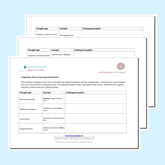
Helping clients see their cognitive assumptions can give them more control over turbulent emotions
“Most misunderstandings in the world could be avoided if people would simply take the time to ask, ‘What else could this mean?'”
– Shannon L. Alder
“All at sea!”
That’s how my client Kathy described her emotional life. I asked her what she thought about before she became “drowned”, as she put it, by episodic feelings of sadness.
“I don’t know what I think. It just comes over me!”
When you feel something, what are you thinking? I guess it can be hard to tell. Experiences don’t come in neatly packaged cognitive parcels or inwardly verbalized statements.
If I feel sad, or inadequate, or irritated, I’m reacting rather than thinking. I can have thoughts about my reactions, or even the circumstances around my reaction, but the actual reaction itself, the feeling, isn’t really cognitive. It doesn’t come from my thinking so much as from my instinctual training, which often bypasses thought altogether.
What’s more, it may only be later, when I’m calm, that I can reflect and observe the biases and assumptions that underpinned my emotional reactions.
When looking at cognitive restructuring, which consists of learning to identify and reframe troublesome cognitions (that’s thoughts to you and me!), there’s something important we need to consider.
Understanding your client’s lived experience
It’s all too easy to get overly abstract and analytical when it comes to the cognitive aspect of your therapy.
Breaking people down into bits without looking at them holistically is prevalent in some corners of physical medicine.
Once, after doing something indescribably stupid, I experienced an unspeakably painful injury to my elbow. The emergency doctor never addressed me once as a human being but simply spoke about the different parts of my arm, which he referred to as “it”. He did refer to “the patient” a couple of times – without looking at me – and that was as human as the experience got.
Likewise, in the psychological realm, viewing people as just the sum of their thoughts can make us lose the gestalt of our clients’ immediate reality. People are not simply a collection of thoughts that produce feelings, but a blend of perceptions, sensations, actions, thoughts, and feelings. And of course, feelings produce thoughts as much as the other way about.
Someone with a perceptual bias towards, say, low self-esteem will live the experience of a sense of inadequacy. Their mind may automatically pattern match to whatever life offers up without them thinking much at all. But though they might not think, “I am not good enough“, they certainly feel it.
So how do we help our clients who suffer from troublesome, limiting, but hidden assumptions?
A vital question for your clients
The cognitive part of therapy involves asking clients not so much what they think just before they become enraged or feel anxious, but rather:
If that feeling were a thought, what would it be?
The simplistic idea that thoughts produce feelings no longer really holds water, especially if the feelings are powerful.1 Once we recognize that many of our clients’ troublesome reactions to life are not even particularly conscious, let alone framed in terms of clear verbal cognitions, we can help our clients:
- calm the troublesome feelings enough to actually unwrap the hidden assumptions and limiting beliefs that may lie hidden within the feeling, and
- bring their reactions into the realm of consciousness or cognition so that they can see their own limiting assumptions from the outside as it were, and therefore gain more volition over the activity of their minds.
We can help clients heal in all sorts of ways, from detraumatizing the terror of horrific memories to calming the mind of the client with generalized anxiety disorder, anger, or addiction.
And while it’s true that strong emotion drives thoughts rather than the other way about, once we have calmed our client’s agitated mind, then we have a chance to help them both examine their cognitive assumptions and begin to change the ones that don’t serve them or reflect reality fairly.
I’ve written before about the most common cognitive distortions, but now I want to look at more ways we can help our clients not only see their cognitive assumptions at play but also start to take charge and have more choice over troublesome emotional thinking.
Four steps to effective cognitive restructuring
Once you have helped calm the strong emotions down, your client will often naturally start to think differently and with more adaptive flexibility. If I am terrified in a specific situation, I will tend to see things in stark and limited ways. But if I become relaxed in that same situation, I will be able to consider multiple perspectives and become flexible.
Here are some specific techniques you can use to help clients think in ways that help rather than harm them.
Step one: Talk to your client about how cognitive biases work
When a pattern of behaviour or thought is laid bare before us, we begin to see its effect on us more clearly. If I say to a depressed client something like: “People who are depressed often see things in all-or-nothing terms”,2 I am giving them a chance to see their own thinking more objectively. They might say something like, “Ah, that sounds like me!”
When I describe how strong emotion makes us think too simplistically, or how sadness, anxiety, and other feelings can make people see positives as unlikely to last but negatives as likely to always be there, I’m laying the pattern of some of these common cognitive distortions bare for my clients to see.
I am not saying “This is how you think and it’s wrong!” because people learn better when they are allowed to make their own connections.
But in order to really impact our clients, we need to help them be open to new ways of seeing.
Step two: Help open your client’s mind so it can heal
The mind needs to be open to change. Cognitive reframing needn’t be a question of simply suggesting your client “think about it like this”, or telling them they are thinking about things in the wrong way. Quite the contrary – clients may double down on their biases (even if those biases harm them) when directly confronted.
So we may need to be subtle and respectful of even limiting beliefs. The first step may be to help your client open their mind enough to accept the possibility of broader perspectives.
We can help clients observe their own thinking distortions by using these three techniques:
- Calm the client so that their emotions no longer force their thoughts to adhere to their limiting life perspectives.
- Use metaphor so that the pattern of seeing things in less limiting ways is presented to the part of the mind that is less analytical and can assimilate new perspectives.
- Use Socratic questioning, which non-confrontationally helps clients exercise the part of their minds that can both observe limitations in thought and also calmly examine wider and therefore more diverse ways of seeing situations.
In many ways, emotionally driven thinking persists only because it remains unchallenged. We can help our clients learn to ‘see through’ the ‘propaganda’ of emotional reasonings such as depressive biases, and not give these kinds of thoughts such a free pass.
Step three: Help your clients question their own assumptions
We can encourage our clients to ask themselves:
- What is the actual evidence for my take on this?
- If there is evidence, what can I practically do to improve things?
- If there is no real evidence, and it seems to be just my imagination working overtime, what is a bigger, more realistic way of looking at this?
- Is there enough evidence yet for my way of looking at this, or do I need to relax with not knowing for a while until real evidence emerges?
This last point relates to a meaning vacuum, in which we hold off from filling an ambiguous situation with concocted meaning before we have any real evidence.
For example, one client often felt terrified when her boyfriend went a bit quiet. She was quick to fill the meaning vacuum with her imaginings (He’s thinking about breaking up with me! He doesn’t love me anymore!). And because her imaginings felt so real, she assumed they must be true.
Bit by bit she learned to generate many possible explanations, not just the most extreme and scary ones. But more than this, she developed the capacity to hold off from prematurely assigning meaning to ambivalent situations and grew much more secure and happy.
Once we have helped our clients see their cognitive distortions more objectively and shown them how to use cognitive restructuring, we can also task them with continuing to do this in their own time.
Step four: Set the task of spotting cognitive distortions and developing flexible perceptions
We can task clients to observe and write down times when they are using fatalistic or all-or-nothing thinking. We can ask them to:
- be ready to catch themselves leaping to unfounded conclusions,
- write down times when they observe themselves using cognitive distortions,
- challenge thinking errors once they have spotted them, and
- practise holding a meaning vacuum when little evidence is actually present.
We can then ask them to bring what they’ve written down to the next session so that we can talk about what happened and discuss any other possible ways they could have thought about or viewed those situations. In this way we are helping them develop their minds to feel and think in more flexible and even ways. Pretty soon they will naturally find they use restricted modes of thought less, and open up to life more.
Kathy, who I mentioned at the start of this piece, found it really useful to see how she had been thinking in emotionally driven extremes and actually enjoyed the process of becoming more moderate in her thinking – less all-or-nothing and more able to see gradations of meaning in life. She told me she felt like she was starting to steer her own ship again.
We don’t want our clients to become so self-absorbed and inwardly analytical that they lose the capacity to live spontaneously. But in life, as at sea, we need to be able to gently steer our ship before we hit rocks if we are going to get to where we need to be.
I’ve created a worksheet that can be given to the client to help them spot cognitive distortions and then challenge them. The Challenge/exception column is left blank for them to fill in. I recommend you work through at least one or two with them so they get the idea. (Note that all the cognitive distortions actually involve all-or-nothing thinking.)
Click here to download the PDF worksheet
Improving a client’s motivation
This client is feeling much better since his first session for imposter syndrome. He says that last time he came he felt “deeply unhappy” about it all but now he’s much more relaxed. He no longer feels he has imposter syndrome or that he is inferior to people he sees as more articulate than himself. In fact he talks about how many people seem to use over-complicated jargon as a way of making themselves feel more like the ‘real deal.’
He is semi-retired and simply wants to see a couple of private clients a week. He feels in this session he needs a ‘kick up the backside’. So although he feels he no longer has imposter syndrome, he wants help with his motivation. He also wants to feel more relaxed when talking to “official” people such as those in the police about providing therapeutic help for them.
Members of Uncommon Practitioners TV can watch this session online now, and if you’d like to join, you can sign up here to be notified when booking is open.
Notes:










